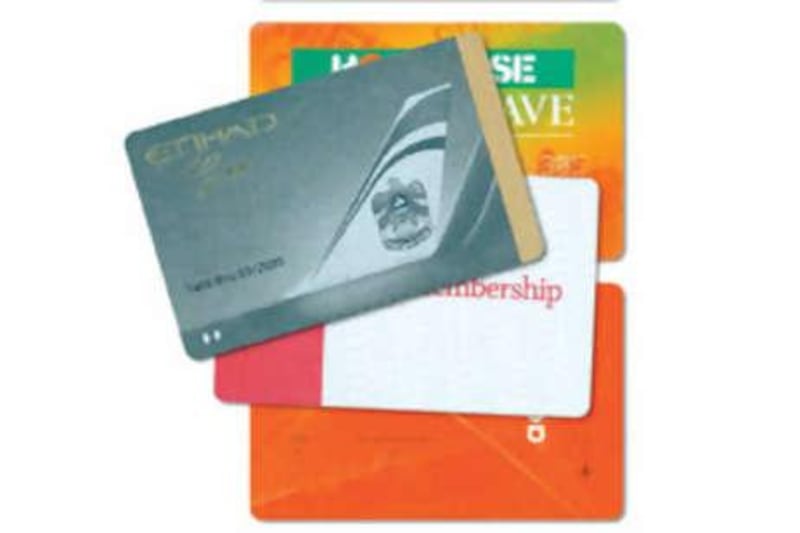Ever since American Airlines pioneered the first modern customer loyalty programme 27 years ago, frequent-flyer and -buyer schemes have become a common part of the consumer experience. But a colourful plastic membership card does not mean a customer's loyalty is in the bag. Throughout the Middle East a variety of businesses, from banks and hotels to supermarkets, are dangling customer perks in exchange for patronage, especially in the region's consumption capital, the UAE. A Government report issued last week said that UAE consumers spent seven times more than the rest of the region.
It is a competitive marketplace in which, it seems, the little extras from loyalty programmes can go a long way with some customers. The Centrepoint Privilege Club, operated by the UAE-based retail conglomerate, Landmark Gulf Group, has more than a million cardholders in the GCC, including 320,000 in the UAE. Every month, 5,000 new members sign on here, to earn points that go towards redeemable vouchers at stores, including Babyshop, Shoe Mart and Home Centre, according to P K Faisal, the group's manager of relationship marketing.
He said that Landmark expected to have between six and seven million loyalty card members in the GCC within four years. Emirates airline's Skywards frequent flyer programme has 3.6 million members. It was growing by 30 per cent a year, with an average of 1.5 new members joining every minute, said Brian LaBelle, the senior vice president at Skyward. But membership numbers are not the key figures to look for, according to Colloquy, a loyalty marketing consulting group based in the US.
"Fat membership rolls may look good in a press release or a company's annual report, but active loyalty programme members are the only members who count," it said in a report last year. Mr Faisal said that, on average, each Centrepoint Privilege Club member made seven to eight transactions a year. "The average value of a transaction is increasing by 30 per cent per annum per customer," he said. Sales to customers with loyalty cards now accounted for 40 per cent of the company's business, he pointed out, compared to just three per cent in 2000, a year after the scheme was introduced.
Mr LaBelle would not say how active Skywards members were, and how often they purchased plane tickets, but he acknowledged that the airline was interested in developing "the quality of the membership base rather than the quantity". Skywards, like most travel loyalty programmes, has gone beyond the traditional points-for-free-travel and upgrades formula to offer deals on auxiliary services like rental cars and hotels.
While members claimed about 200,000 free flights every year, they also picked up some 150,000 non-air rewards, Mr LaBelle said. By the beginning of 2005, almost 14 trillion frequent flyer miles had been accumulated worldwide, a global stock that was worth more than US$700 billion (Dh2.57 trillion) at the time, according to Economist magazine. "The number of outstanding miles has risen by over 20 per cent a year," said Peter Baumgartner, the executive vice president of marketing at Etihad. "At the current rate of redemption it would take up to 25 years for the global stock to be redeemed."
Mr Baumgartner added that one of the biggest problems with traditional points-for-seats programmes was that "the carrot hangs too high". "Thirty per cent of people in traditional frequent flyer schemes never reach the cheapest reward," he said. "In our programme, your first mile counts for something." The Abu Dhabi-based airline's two-year-old loyalty programme, Etihad Guest, will have 500,000 members by the year's end and offers more than 900 non-air products, including backstage passes to the filming of TV shows.
The programme allows consumers to use a combination of both miles and cash to redeem a reward. In this way, the airline can entice the least active 30 per cent of loyalty club members to contribute cash and claim a perk. "The more cash you contribute, the higher the value of one mile," said Mr Baumgartner. Emirates has also introduced a miles-plus-cash approach for UAE-based members. But, despite the burgeoning prizes-for-points economy, Tarek Mady, the chair of marketing at the American University in Dubai, said that many consumers would shelve loyalty to a particular retailer if a better deal existed with one of its competitors. "Consumers aren't loyal," he said. "They crave variety and a good deal."
The key for businesses, Dr Mady said, was to make sure consumers "want to come back, even without the loyalty programme". "The best brands in the world know that what gets repeat business is satisfaction with a product or service, a deep belief in the brand the customer is getting," he said. "When someone gets into a loyalty programme, that's not the main reason why they buy something, it's just the icing on the cake."
Dr Mady said that loyalty cards were a misnomer and that many consumers knew that. "They're used as marketing research tools, not for customer loyalty. They're marketing research in disguise," he said. The Clubcard loyalty programme operated by the UK's largest retailer, Tesco, and monitored by the supermarket chain's marketing firm, Dunnhumby, has arguably made the most of the market research capability of a loyalty programme.
Launched in 1995, the Clubcard scheme has more than 11 million active users and offers customers points that are redeemable within the Tesco chain of businesses. Like most loyalty programmes, Clubcard keeps tabs on what consumers purchase, how often they shop and what their buying preferences are. "This essential information on actual buying behaviour has guided most of the key business decisions that the Tesco management team has made in recent times, reducing the risk associated with bold new initiatives," the Dunnhumby website said.
Dunnhumby said it did not sell customer information to third parties, although privacy issues have spawned concern among civil libertarians. There are other potential pitfalls as well. Companies can quickly alienate the customers they are trying to keep if their reward schemes are complicated or perceived as lacking - which will backfire on their brand. "The hassle associated with redeeming your points becomes a monster," Dr Mady said. "You're supposed to give them [customers] a reason to stay, but you're giving them a reason not to leave. People can get stuck in loyalty programmes and become discontented with the brand."
Mr Faisal said that the key was to ensure that customers felt that there was value in being a card member. The points redemption system should be simple and easy to understand, he said, "otherwise it will quickly backfire". Mr LaBelle said that Skywards's rewards started at 5,000 miles, in a bid to ensure that every member can redeem rewards. "If you fly from here to London you get 6,400 miles," he added.
The main premise of loyalty cards is that it is cheaper to keep existing customers, whose purchasing preferences are already known, than to attract new ones. "The reason we give discounts is basically to track transactions," Mr Faisal said. "The reason for giving points is not just as a reward, it's an enticement to swipe the card. If you don't exploit the information, don't expect the card to do wonders for you."
Mr Faisal would not reveal how much Landmark's loyalty programme was costing the group, but said that it "has been a very fruitful experience for us". He acknowledged that it would take time to reach its full potential. "Perhaps 10 years later, when 70 to 80 per cent of your customers are part of your loyalty programme, you don't have to spend as much money on advertising," Mr Faisal said. "That's when a loyalty programme becomes effective. It's a more cost-effective and sure way to reach customers."





